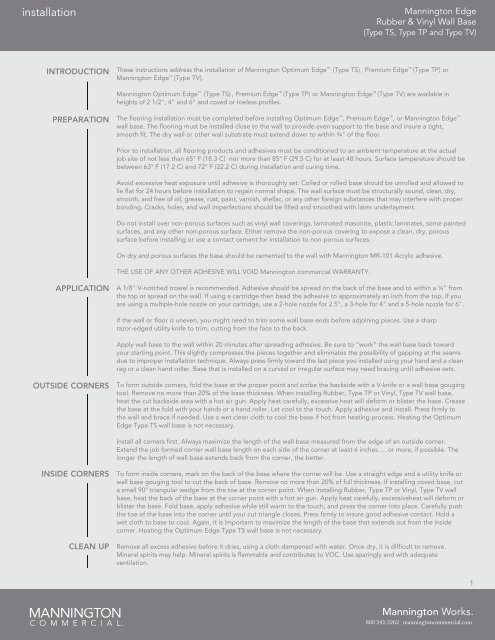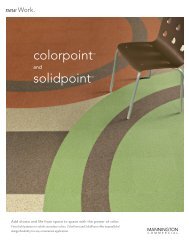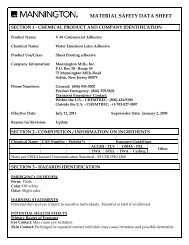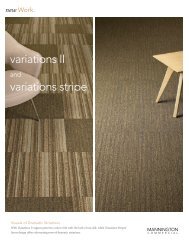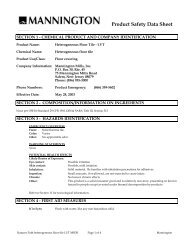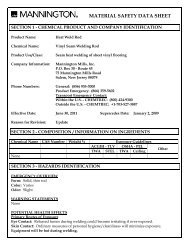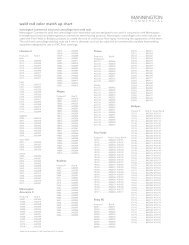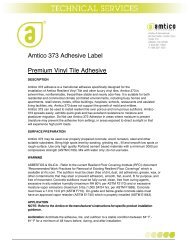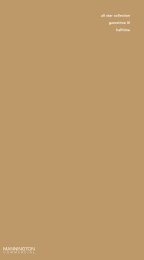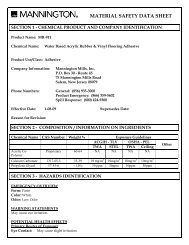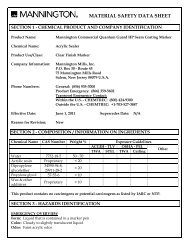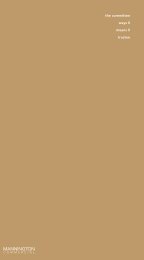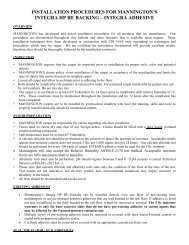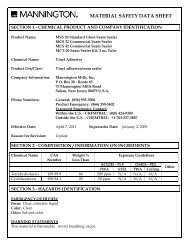Rubber and Vinyl Wall Base Installation - Mannington
Rubber and Vinyl Wall Base Installation - Mannington
Rubber and Vinyl Wall Base Installation - Mannington
You also want an ePaper? Increase the reach of your titles
YUMPU automatically turns print PDFs into web optimized ePapers that Google loves.
installation<strong>Mannington</strong> Edge<strong>Rubber</strong> & <strong>Vinyl</strong> <strong>Wall</strong> <strong>Base</strong>(Type TS, Type TP <strong>and</strong> Type TV)INTRODUCTIONThese instructions address the installation of <strong>Mannington</strong> Optimum Edge (Type TS) , Premium Edge (Type TP) or<strong>Mannington</strong> Edge (Type TV).<strong>Mannington</strong> Optimum Edge (Type TS) , Premium Edge (Type TP) or <strong>Mannington</strong> Edge (Type TV) are available inheights of 2 1/2", 4" <strong>and</strong> 6" <strong>and</strong> coved or toeless profiles.PREPARATIONThe flooring installation must be completed before installing Optimum Edge , Premium Edge , or <strong>Mannington</strong> Edge wall base. The flooring must be installed close to the wall to provide even support to the base <strong>and</strong> insure a tight,smooth fit. The dry wall or other wall substrate must extend down to within ¾" of the floor.Prior to installation, all flooring products <strong>and</strong> adhesives must be conditioned to an ambient temperature at the actualjob site of not less than 65° F (18.3 C) nor more than 85° F (29.5 C) for at least 48 hours. Surface temperature should bebetween 63° F (17.2 C) <strong>and</strong> 72° F (22.2 C) during installation <strong>and</strong> curing time.Avoid excessive heat exposure until adhesive is thoroughly set. Coiled or rolled base should be unrolled <strong>and</strong> allowed tolie flat for 24 hours before installation to regain normal shape. The wall surface must be structurally sound, clean, dry,smooth, <strong>and</strong> free of oil, grease, rust, paint, varnish, shellac, or any other foreign substances that may interfere with properbonding. Cracks, holes, <strong>and</strong> wall imperfections should be filled <strong>and</strong> smoothed with latex underlayment.Do not install over non-porous surfaces such as vinyl wall coverings, laminated masonite, plastic laminates, some paintedsurfaces, <strong>and</strong> any other non-porous surface. Either remove the non-porous covering to expose a clean, dry, poroussurface before installing or use a contact cement for installation to non-porous surfaces.On dry <strong>and</strong> porous surfaces the base should be cemented to the wall with <strong>Mannington</strong> MR-101 Acrylic adhesive.THE USE OF ANY OTHER ADHESIVE WILL VOID <strong>Mannington</strong> commercial WARRANTY.ApplicationA 1/8" V-notched trowel is recommended. Adhesive should be spread on the back of the base <strong>and</strong> to within a ¼" fromthe top or spread on the wall. If using a cartridge then bead the adhesive to approximately an inch from the top. If youare using a multiple-hole nozzle on your cartridge, use a 2-hole nozzle for 2.5", a 3-hole for 4" <strong>and</strong> a 5-hole nozzle for 6".If the wall or floor is uneven, you might need to trim some wall base ends before adjoining pieces. Use a sharprazor-edged utility knife to trim, cutting from the face to the back.Apply wall base to the wall within 20 minutes after spreading adhesive. Be sure to “work” the wall base back towardyour starting point. This slightly compresses the pieces together <strong>and</strong> eliminates the possibility of gapping at the seamsdue to improper installation technique. Always press firmly toward the last piece you installed using your h<strong>and</strong> <strong>and</strong> a cleanrag or a clean h<strong>and</strong> roller. <strong>Base</strong> that is installed on a curved or irregular surface may need bracing until adhesive sets.Outside cornersTo form outside corners, fold the base at the proper point <strong>and</strong> scribe the backside with a V-knife or a wall base gougingtool. Remove no more than 20% of the base thickness. When installing <strong>Rubber</strong>, Type TP or <strong>Vinyl</strong>, Type TV wall base,heat the cut backside area with a hot air gun. Apply heat carefully, excessive heat will deform or blister the base. Creasethe base at the fold with your h<strong>and</strong>s or a h<strong>and</strong> roller. Let cool to the touch. Apply adhesive <strong>and</strong> install. Press firmly tothe wall <strong>and</strong> brace if needed. Use a wet clean cloth to cool the base if hot from heating process. Heating the OptimumEdge Type TS wall base is not necessary.Install all corners first. Always maximize the length of the wall base measured from the edge of an outside corner.Extend the job formed corner wall base length on each side of the corner at least 6 inches … or more, if possible. Thelonger the length of wall base extends back from the corner, the better.inside cornersClean upTo form inside corners, mark on the back of the base where the corner will be. Use a straight edge <strong>and</strong> a utility knife orwall base gouging tool to cut the back of base. Remove no more than 20% of full thickness. If installing coved base, cuta small 90° triangular wedge from the toe at the corner point. When installing <strong>Rubber</strong>, Type TP or <strong>Vinyl</strong>, Type TV wallbase, heat the back of the base at the corner point with a hot air gun. Apply heat carefully, excessiveheat will deform orblister the base. Fold base, apply adhesive while still warm to the touch, <strong>and</strong> press the corner into place. Carefully pushthe toe of the base into the corner until your cut triangle closes. Press firmly to insure good adhesive contact. Hold awet cloth to base to cool. Again, it is important to maximize the length of the base that extends out from the insidecorner. Heating the Optimum Edge Type TS wall base is not necessary.Remove all excess adhesive before it dries, using a cloth dampened with water. Once dry, it is difficult to remove.Mineral spirits may help. Mineral spirits is flammable <strong>and</strong> contributes to VOC. Use sparingly <strong>and</strong> with adequateventilation.<strong>Mannington</strong> MR-101 Acrylic adhesive is a white, solvent-free, environmentally safe base adhesive to be used wheninstalling on any clean, dry, non-porous surface. For porous surfaces, use contact cement.1<strong>Mannington</strong> Works.800 241 2262 manningtoncommercial.com
installation<strong>Mannington</strong> Edge<strong>Rubber</strong> & <strong>Vinyl</strong> <strong>Wall</strong> <strong>Base</strong>(Type TS, Type TP <strong>and</strong> Type TV)recommendedadhesive<strong>Mannington</strong> MR-101 Acrylic adhesive is a white, solvent-free, environmentally safe base adhesive to be used wheninstalling on any clean, dry, non-porous surface. For porous surfaces, use contact cement.2<strong>Mannington</strong> Works.800 241 2262 manningtoncommercial.com


